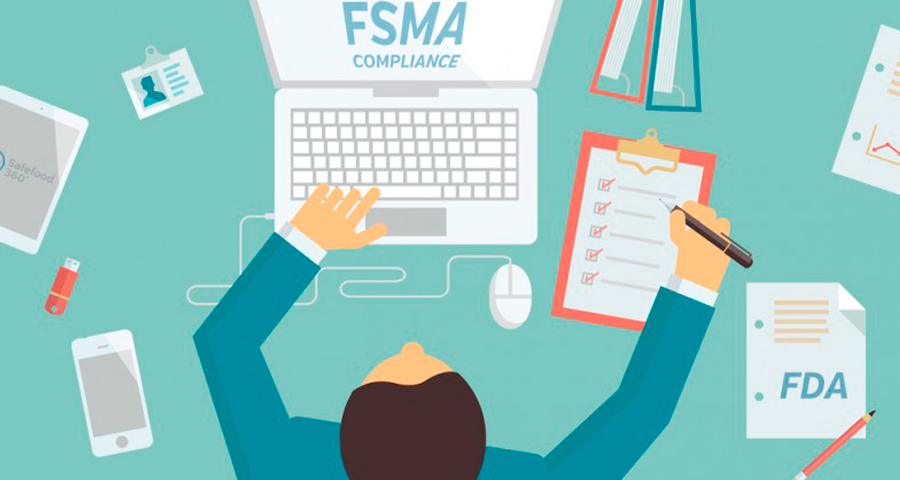Avoid These Common Mistakes When Preparing a FSMA-Compliant Food Safety Plan

Since the Food Safety and Modernization Act (FSMA) went into effect in 2011, U.S. companies have had to take their food safety practices to a new level. The law introduced substantial changes, such as a stronger focus on prevention, new hazards to consider (radiological, allergen control, and economically motivated adulteration), more transparency and accountability, and a closer inspection of the supply chain.
Adapting to these provisions means new challenges for food businesses, especially when it comes to preparing the food safety plan, the written document or set of documents in which companies must explain how they prevent food safety incidents from happening and how they’ll manage an emergency if one does happen.
Prevention’s Biggest Enemy: Complacency
The authors of the FSMA greatly reduced the application of Hazard Analysis and Critical Control Points (HACCP) in favor of a framework called Hazard Analysis Risk-Based Preventive Controls (HARPC). Compared to HACCP, HARPC is more proactive, less reactive, and has a stronger focus on risk-based prevention. For food companies, one of the practical consequences of this shift is that steps and procedures that were part of HACCP’s Prerequisite Programs are mandatory in HARPC.
Although this is a significant change, according to Nancy Scharlach, president and chief technical director at FSMA International, many operators tend to think that preventive controls are just HACCP with a different name. “A lot of companies are too complacent, still in the mindset that they only have to make a few tweaks to their HACCP plan in order to be FSMA compliant,” she says. “In fact, we’ve grown beyond HACCP. The FDA felt that it didn’t cover all of the critical recall subject matters like allergens, environmental pathogens on ready-to-eat food, and food fraud from within the supply chain.”
The other risk of a complacent attitude is to have a false sense of security. “When companies use their HACCP plan as a reference to build their FSMA food safety plan, sometimes they don’t carry risks over,” says Mathew Suri, president of Essential Food Safety Consulting. “If they identified a hazard in their HACCP plan but never experienced a problem with that hazard, they just might not include it in their risk assessment, when in fact they still need to keep track of it as a potential hazard.”
Another common mistake is not being specific enough. “Many food safety plans that we review worldwide are too generic,” says Scharlach. “You’ll see a hazard analysis that simply says: ‘biological hazard,’ ‘pathogens,’ or ‘allergens.’ But you need to know which allergens or pathogens are unique to your production line.”
For Brian Perry, senior vice president of food safety and quality at TreeHouse Foods, a manufacturer and distributor of private-label packaged foods and beverages, conducting a correct hazard analysis was one of the main challenges to making his company’s food safety plan FSMA compliant. “One of the things that we worked to improve upon across the board was making sure that we’re looking at all the inputs from the supply chain and at our risk assessment in a broad sense. We tend to focus very much on microbiological hazards because of the public health elements, but we can’t ignore radiological, chemical, and physical hazards.”
Finding the Right Resources
What complicates things further for food companies is that they don’t always know where to find resources and guidance to put together a food safety plan, making the mistake of falling back into what they already know.
According to Perry, companies shouldn’t be insular in their risk assessment. They should actively seek expert opinions and use all the materials provided by the FDA and other food safety institutions.
Kevin Byrne, senior consultant at Essential Food Safety Consulting, says most companies don’t do enough research. “Especially if you’re a smaller company with little time to look at what’s out there, you may not be aware that other hazards exist, so you can’t complete a thorough assessment of your ingredients, process steps or finished products. For example, something that a lot of people don’t even realize is that the FDA put out an appendix to the draft guidance on the food safety plan, which covers all of the biological and chemical hazards that you would expect to encounter with different ingredients based on their category. It’s a huge reference, but not a lot of people are aware that it even exists.”
Make Your Food Safety Plan Crisis Ready
Managing a food safety emergency requires a lot of intense decision making, including knowing when to issue a recall or not. “There are a lot of layers involved, but if there’s even a chance that misbranding or adulteration occurred and you can’t prove that it didn’t, you still have to initiate a recall,” Scharlach says.
According to Byrne, the first step is obviously to assess the impact by identifying which customers the product was sold to and then to take care of the regulatory aspects by contacting the appropriate people.
The part of the food safety plan about crisis management should be a tool that helps quality and safety teams make the right decisions quickly. Unpredictability is an objective limit here: When prevention fails, there are an infinite number of things that can go wrong, and it would be impossible to include all of them in the recall plan—in fact, this isn’t what the FDA expects. “What the FDA wants to see in your recall plan isn’t necessarily the hundred different scenarios that could happen. What they want to see is that you have a list of key contacts, both internal and external, and a step-by-step protocol that the recall team will follow in order to decide on, initiate, and follow through with the recall process,” Scharlach says.
Do Mock Recalls, but Do Them Right
A good way to bridge this gap as much as possible is by conducting mock recalls, but they need to be done the right way.
“A lot of businesses do mock recalls, but once they know which customers are being affected and they can account for everything, they stop the exercise,” Byrne says. He suggests companies add more specific steps to their mock recalls, such as root cause analysis and the drafting of a press release.
“You may think you’re doing a mock recall, but all you’re really doing is a traceability exercise,” adds Suri. “That’s only one aspect of a mock recall, though. There are several other things that have to be done, sometimes concurrently,” says Suri.
Mock recalls aren’t just for rehearsing for an emergency, but also to find out if there are any gaps in your recall plan. “[Businesses] put a plan together that looks like it should hold up procedurally, but practically they’ve missed steps because they’ve never really mocked the process the whole way through. So when an actual recall shows up, they’re lost,” Suri says. “You might not be able to role play every potential situation, but we encourage our clients to pick a different scenario each time and role play it out fully twice a year. That way, you wind up gaining experience with a wide gamut of issues.”
Byrne also warns food companies away from taking a superficial approach toward corrective action through a lack of monitoring. “We see a lot of companies identify the problem and what the corrective action is or should be, and document that it’s being done. But then they don’t monitor it to make sure that the corrective action is continuing to prevent the problem from reoccurring. I think the main challenge is in making sure that corrective actions go far enough and that you’re not looking at them just as a Band Aid.”
Company Culture Is Key
For Perry, the effort that FSMA has required from food manufacturers has definitely improved food safety standards. “It’s been like a tide that raises the waterline for all boats. The focus on prevention brought a clear improvement and probably helped to weed out some bad actors,” he says.
This higher level of effort puts different challenges in front of both small and large enterprises, requiring them to allocate more time, knowledge and people to their food safety program. “Small companies may have a hard time getting people trained properly, creating bigger budgets around food safety, and understanding how to comply with each element of the law,” Scharlach says.
Larger companies face different issues. “The challenge for us has been to manage a very complex portfolio and still make our food safety plan as simple as possible,” says Perry. “The main difference has been the level of validation, verification, and transparency that we have with our agency partners. As the FDA comes in and reviews our food safety plans, we know that our record keeping must prove that we did what we said we would do.”
Despite all difficulties and misconceptions, there’s no escaping this adaptation to FSMA requirements, no matter how large or small the business. “It’s a matter of sitting down, doing it correctly, rewriting everything properly, and retraining everybody,” Scharlach says. “That takes time, effort, energy, and culture change.”
The key to this culture change is a top-down approach to food safety culture, where companies’ executives are directly involved in the implementation of the food safety plan. One example is TreeHouse’s steering committee, where, Perry explains, the C-suite and the presidents of the divisions meet monthly to review food safety objectives and challenges, and make sure they have visibility and alignment.
By contrast, when all responsibilities are left entirely to employees, the level of food safety culture is often poor. “If the project is dumped on the already overburdened food safety lead or QI-practitioner, then the workforce will resist change resulting in an ineffective plan,” says Jocelyn Lee, consultant at Superior Food Safety. “When food safety culture is embedded from the top down, the preparation of a food safety plan is likely to be smooth, comprehensive, effective, and implementable.”
Source: https://www.foodqualityandsafety.com


